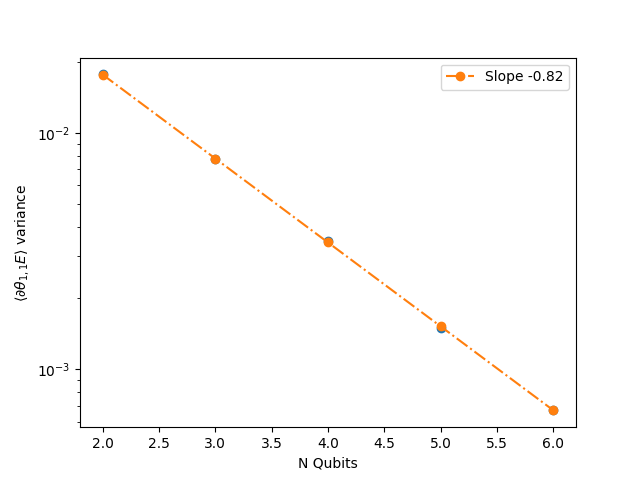Note
Click here to download the full example code
Barren plateaus in quantum neural networks¶
Author: Shahnawaz Ahmed — Posted: 11 October 2019. Last updated: 26 October 2020.
In classical optimization, it is suggested that saddle points, not local minima, provide a fundamental impediment to rapid high-dimensional non-convex optimization (Dauphin et al., 2014).
The problem of such barren plateaus manifests in a different form in variational quantum circuits, which are at the heart of techniques such as quantum neural networks or approximate optimization e.g., QAOA (Quantum Adiabatic Optimization Algorithm) which can be found in this PennyLane QAOA tutorial.
While starting from a parameterized random quantum circuit seems like a good unbiased choice if we do not know the problem structure, McClean et al. (2018) show that
“for a wide class of reasonable parameterized quantum circuits, the probability that the gradient along any reasonable direction is non-zero to some fixed precision is exponentially small as a function of the number of qubits.”
Thus, randomly selected quantum circuits might not be the best option to choose while implementing variational quantum algorithms.
In this tutorial, we will show how randomized quantum circuits face the problem of barren plateaus using PennyLane. We will partly reproduce some of the findings in McClean et. al., 2018 with just a few lines of code.
Note
An initialization strategy to tackle barren plateaus
How do we avoid the problem of barren plateaus? In Grant et al. (2019), the authors present one strategy to tackle the barren plateau problem in randomized quantum circuits:
“The technique involves randomly selecting some of the initial parameter values, then choosing the remaining values so that the final circuit is a sequence of shallow unitary blocks that each evaluates to the identity. Initializing in this way limits the effective depth of the circuits used to calculate the first parameter update so that they cannot be stuck in a barren plateau at the start of training.”
Exploring the barren plateau problem with PennyLane¶
First, we import PennyLane, NumPy, and Matplotlib
import pennylane as qml
from pennylane import numpy as np
import matplotlib.pyplot as plt
Next, we create a randomized variational circuit
# Set a seed for reproducibility
np.random.seed(42)
num_qubits = 4
dev = qml.device("default.qubit", wires=num_qubits)
gate_set = [qml.RX, qml.RY, qml.RZ]
def rand_circuit(params, random_gate_sequence=None, num_qubits=None):
"""A random variational quantum circuit.
Args:
params (array[float]): array of parameters
random_gate_sequence (dict): a dictionary of random gates
num_qubits (int): the number of qubits in the circuit
Returns:
float: the expectation value of the target observable
"""
for i in range(num_qubits):
qml.RY(np.pi / 4, wires=i)
for i in range(num_qubits):
random_gate_sequence[i](params[i], wires=i)
for i in range(num_qubits - 1):
qml.CZ(wires=[i, i + 1])
H = np.zeros((2 ** num_qubits, 2 ** num_qubits))
H[0, 0] = 1
wirelist = [i for i in range(num_qubits)]
return qml.expval(qml.Hermitian(H, wirelist))
Now we can compute the gradient and calculate the variance.
While we only sample 200 random circuits to allow the code
to run in a reasonable amount of time, this can be
increased for more accurate results. We only consider the
gradient of the output with respect to the last parameter in the
circuit. Hence we choose to save gradient[-1] only.
grad_vals = []
num_samples = 200
for i in range(num_samples):
gate_sequence = {i: np.random.choice(gate_set) for i in range(num_qubits)}
qcircuit = qml.QNode(rand_circuit, dev, interface="autograd")
grad = qml.grad(qcircuit, argnum=0)
params = np.random.uniform(0, 2 * np.pi, size=num_qubits)
gradient = grad(params, random_gate_sequence=gate_sequence, num_qubits=num_qubits)
grad_vals.append(gradient[-1])
print("Variance of the gradients for {} random circuits: {}".format(
num_samples, np.var(grad_vals)
)
)
print("Mean of the gradients for {} random circuits: {}".format(
num_samples, np.mean(grad_vals)
)
)
Out:
Variance of the gradients for 200 random circuits: 0.0056815136930815045
Mean of the gradients for 200 random circuits: -0.0010002268976521344
Evaluate the gradient for more qubits¶
We can repeat the above analysis with increasing number of qubits.
qubits = [2, 3, 4, 5, 6]
variances = []
for num_qubits in qubits:
grad_vals = []
for i in range(num_samples):
dev = qml.device("default.qubit", wires=num_qubits)
qcircuit = qml.QNode(rand_circuit, dev, interface="autograd")
grad = qml.grad(qcircuit, argnum=0)
gate_set = [qml.RX, qml.RY, qml.RZ]
random_gate_sequence = {i: np.random.choice(gate_set) for i in range(num_qubits)}
params = np.random.uniform(0, np.pi, size=num_qubits)
gradient = grad(
params, random_gate_sequence=random_gate_sequence, num_qubits=num_qubits
)
grad_vals.append(gradient[-1])
variances.append(np.var(grad_vals))
variances = np.array(variances)
qubits = np.array(qubits)
# Fit the semilog plot to a straight line
p = np.polyfit(qubits, np.log(variances), 1)
# Plot the straight line fit to the semilog
plt.semilogy(qubits, variances, "o")
plt.semilogy(qubits, np.exp(p[0] * qubits + p[1]), "o-.", label="Slope {:3.2f}".format(p[0]))
plt.xlabel(r"N Qubits")
plt.ylabel(r"$\langle \partial \theta_{1, 1} E\rangle$ variance")
plt.legend()
plt.show()

References¶
Dauphin, Yann N., et al., Identifying and attacking the saddle point problem in high-dimensional non-convex optimization. Advances in Neural Information Processing systems (2014).
McClean, Jarrod R., et al., Barren plateaus in quantum neural network training landscapes. Nature communications 9.1 (2018): 4812.
Grant, Edward, et al. An initialization strategy for addressing barren plateaus in parametrized quantum circuits. arXiv preprint arXiv:1903.05076 (2019).

